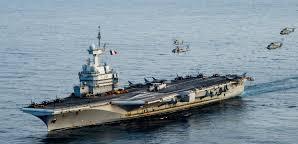French Naval Power in Indo-Pacific: A Strategic Analysis
France’s Charles de Gaulle carrier strike group’s upcoming deployment to the Indo-Pacific marks its first in 40 years, signaling France’s ambition to expand its military presence beyond traditional spheres of influence amid shifting global dynamics.

The French Navy’s announcement of deploying its nuclear-powered aircraft carrier Charles de Gaulle and its strike group to the Indo-Pacific region represents a significant shift in French military strategy. This deployment, while seemingly impressive on paper, deserves a careful examination of its practical implications and strategic significance.
The Charles de Gaulle carrier strike group’s composition reveals both capabilities and limitations. The nuclear-powered carrier, while being the only non-U.S. nuclear carrier in service, is relatively modest in size at 42,000 tons. Its strike group includes one destroyer, two frigates, one supply ship, and one nuclear submarine – essentially committing half of France’s total naval combat power to this mission.
Several factors drive this deployment. First, it demonstrates France’s commitment to maintaining its status as a global military power. The mission includes planned joint exercises with India and other nations in the Indian Ocean, followed by drills with Japan, the United States, and Australia in the Pacific. This aligns with France’s broader strategy of deepening partnerships in the “Indo-Pacific region,” as stated by the French Embassy in Japan.
However, the deployment faces significant practical constraints. The Charles de Gaulle’s limitations include slower aircraft launch capabilities due to its older catapult system and restricted simultaneous flight operations. The carrier’s Rafale fighter jets, while capable, operate without stealth capabilities and with limited radar coverage due to smaller antenna dimensions.
The strategic implications extend beyond military capabilities. This deployment serves multiple diplomatic purposes: reinforcing France’s role in European collective defense, demonstrating military value to American allies, and maintaining relevance in global security discussions. However, military experts note that European naval deployments to Asia, while politically significant, may contribute to regional tensions rather than stability.
From a historical perspective, this deployment marks a departure from France’s traditional focus on the Mediterranean and African regions. It reflects a broader shift in global power dynamics, where European nations increasingly seek to establish presence in the Indo-Pacific theater, despite having limited practical capability to influence regional security outcomes.
The timing of this deployment coincides with similar moves by other European naval powers. The British carrier HMS Prince of Wales and Italian carrier Cavour have also scheduled visits to Japan, indicating a coordinated Western naval presence in the region. This pattern suggests a larger strategic realignment rather than an isolated French initiative.
This naval deployment illustrates the complex interplay between military capability and diplomatic signaling in modern international relations. While France’s naval assets may be modest compared to major regional powers, the political message of commitment to Indo-Pacific security carries significant diplomatic weight.